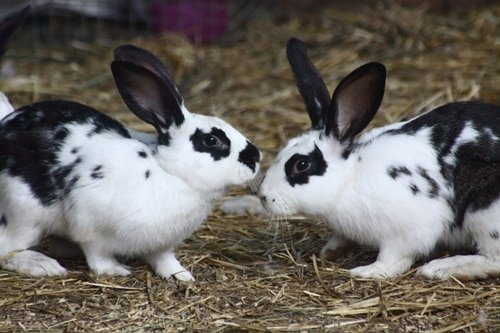How Do Rabbits Establish Dominance in a Bonded Pair

Rabbits are social creatures and do best when kept in pairs. When two rabbits are bonded, they will establish a hierarchy with one rabbit being dominant over the other. The dominant rabbit will be the one who initiates all the activity and dictates what the other rabbit can and cannot do.
The subordinate rabbit will usually yield to the dominant rabbit’s wishes and follow their lead.
In the wild, rabbits live in social groups called warrens. A warren can be as small as two rabbits or as large as 100. The size of a warren depends on the amount of food and shelter available in the area.
Each rabbit in a warren has a specific role to play in order for the group to function properly.
Rabbits form close bonds with other members of their warren and these bonds are essential for their survival. In a bonded pair, rabbits establish dominance through physical and vocal cues.
The dominant rabbit is usually larger and heavier than the subordinate rabbit. The dominant rabbit also tends to be more aggressive, although this is not always the case.
The subordinate rabbit will usually submit to the dominant rabbit by crouching down or lying on its back.
The subordinate rabbit may also make submissive vocalizations, such as grunting or squealing. If the subordinate rabbit does not show sufficient submission, the dominant rabbit may resort to aggression, such as biting or chasing.
Once dominance has been established, it is rare for there to be any further disputes between the two rabbits.
They will typically live harmoniously together from then on out.
My Rabbit is Bullying My Other Rabbit
If your rabbits are fighting, it may be because one is bullying the other. Rabbits can be very territorial, and sometimes a rabbit will assert dominance over another by acting aggressively. This might include lunging, biting, growling, or chasing the other rabbit around.
If you think your rabbit is bullying another, there are a few things you can do to help.
First, try to figure out why the aggression is happening. Is it because one rabbit is claiming territory?
Is there something that’s triggering the aggression, like competition for food or attention? Once you know what’s causing the problem, you can start to work on solving it.
One way to reduce aggression is to make sure each rabbit has its own space.
This means having separate food and water bowls, litter boxes, and hiding spots. Each rabbit should also have plenty of toys and chewables to keep them occupied. If two rabbits are fighting over a particular item, try giving each of them their own version of that item (for example, two different kinds of chew toys).
You can also try training your rabbits using positive reinforcement – rewarding them when they display calm behavior around each other. With patience and perseverance, you should be able to help your rabbits get along better with each other!
How Does a Rabbit Show Submission
A rabbit can show submission in many ways, but the most common is by flattening its ears back against its head. This is a clear sign that the rabbit is feeling submissive and wants to avoid any conflict. Other signs of submission include crouching down low to the ground, tucking its tail between its legs, and licking another rabbit’s face.
If a rabbit is repeatedly showing these signs of submission, it likely means that it feels subordinate to another rabbit in the group and is trying to avoid any confrontation.
What Does It Mean When a Rabbit Cleans Itself in Front of You
Rabbits are very clean animals and they spend a lot of time grooming themselves. When a rabbit cleans itself in front of you, it is actually showing you that it trusts you. It feels comfortable enough around you to groom itself without feeling like it has to hide or be on guard.
This is a really good sign if you are hoping to bond with your rabbit!
How to Assert Dominance Over a Rabbit
If you’ve ever wanted to assert dominance over a rabbit, here’s how to do it. First, get the rabbit into a comfortable position. Next, make sure that your body is in a position of power over the rabbit.
Finally, use your body language and vocalizations to show the rabbit who’s boss.
1. Get the Rabbit Into a Comfortable Position
The first step is to get the rabbit into a comfortable position.
You don’t want to startle or scare the rabbit, so make sure that you approach it slowly and calmly. Once you’re close enough, gently pick up the rabbit and hold it close to your body. If the rabbit seems tense or uncomfortable, try stroking its fur in a soothing manner.
2. Make Sure That Your Body Is in a Position of Power Over the Rabbit
Now that you have the rabbit in a comfortable position, it’s time to take control of the situation by putting your body in a position of power over theirs. Stand tall and make sure that your posture is relaxed but confident.
Avoid looming over the rabbit or making any sudden movements – remember, you want to appear calm and in control.
3 Use Your Body Language and Vocalizations To Show The Rabbit Who’s Boss
Once you’re in a position of power over the rabbit, it’s time to start using your body language and vocalizations to assert dominance .
Keep eye contact with the rabbit at all times , and speak in a deep , firm voice . Avoid using high-pitched tones or making any sudden noises – you want to sound calm and confident . Additionally , avoid touching or petting the rabbit unless absolutely necessary .
How Do Bunnies Show Affection
Bunnies are social creatures that need companionship to thrive. They show affection in both human and bunny relationships through physical contact and bonding behaviors.
Physical Contact
One way bunnies show affection is by seeking out physical contact. They’ll nudge you with their nose, head-butt you, or even rest their chin on your finger. If you’re petting a bunny and they start to close their eyes, it means they’re really enjoying it!
Some bunnies also like to be picked up and cuddled, though not all will enjoy this type of handling. If your bunny doesn’t seem to like being picked up, try gently stroking them along their back instead.
Bonding Behaviors
Bunnies also bond with each other and with humans through shared activities and rituals. For example, many bunnies love to have their ears rubbed together (this is called “bunny kissing”). You might also see your bunny grooming themselves or another bunny – this is another way of showing affection.
And finally, binkying! This adorable behavior looks like a combination of a jump and a twist mid-air – it’s a sure sign that your bunny is happy and content!

Credit: rabbitwelfare.co.uk
How Do Rabbits Assert Dominance?
Rabbits assert dominance through a variety of means, including physical aggression, territoriality, and social hierarchy. In the wild, rabbits live in social groups called warrens. Within a warren, there is a strict social hierarchy that is maintained through aggressive behaviors such as biting, chasing, and mounting.
The most dominant rabbit in the group is typically the largest and most aggressive individual. This rabbit will have first access to food and mates, and will be able to assert its dominance over other members of the group. If a subordinate rabbit challenges the dominant individual, it will likely be met with aggression and may even be killed.
In captivity, rabbits can also assert their dominance through aggression and territoriality. They may bite or chase their owners or other animals in the home in order to establish themselves as the alpha individual. Additionally, rabbits may mark their territory with urine or feces in order to keep other animals away.
It is important to understand how rabbits assert their dominance so that you can provide them with an appropriate environment and avoid potential conflict.
Can Two Dominant Rabbits Bond?
If you are considering bonding two rabbits, it is important to know that they can be very difficult. Two dominants will often have a hard time living together because they will constantly be trying to assert their dominance over each other. This can result in fighting, which can sometimes be serious enough to cause injury or even death.
If you do Bond two rabbits, it is important to carefully monitor them and be prepared to separate them if necessary.
Why Do Bonded Rabbits Fight?
Bonded rabbits who have been together for a while will sometimes start fighting. This can be due to a number of reasons, such as territory issues, changes in the hierarchy of their relationship, or simply because they are bored and need something to do.
Fighting between bonded rabbits is not usually serious and is often just a way for them to let off steam.
However, if the fighting starts to become frequent or violent, then it may be an indication that something is wrong and you should take your rabbits to the vet for a check-up.
What Happens When You Separate a Bonded Pair of Rabbits?
When you separate a bonded pair of rabbits, they will both experience a period of grieving. This can manifest in different ways, such as withdrawn behavior, lethargy, reduced appetite, and increased aggression. The length of time it takes for them to grieve varies from rabbit to rabbit, but it is generally a good idea to give them at least a few weeks to adjust before reintroducing them to other rabbits.
Dominance in a Rabbit Pair
Does the Process of Establishing Dominance in a Bonded Pair Affect a Rabbit’s Ability to Digest Cellulose?
Establishing dominance in a bonded pair of rabbits does impact how rabbits digest cellulose. The dynamics of dominance can affect stress levels, which play a crucial role in digestive health. A stressed rabbit may develop gastrointestinal issues, hindering the efficient breakdown of cellulose. Therefore, understanding and managing dominance plays a crucial role in ensuring optimal cellulose digestion in rabbits.
Does Barbering Behavior in Rabbits Indicate Dominance?
Grooming behavior in rabbits can serve as a potential indicator of dominance. When one rabbit grooms another, it can be a display of social hierarchy, with the groomer asserting dominance. This behavior is common among rabbits, especially in groups, as they establish and maintain their hierarchical positions through grooming interactions.
Conclusion
Rabbits are social creatures and will usually bond with another rabbit if given the chance. When two rabbits are bonded, they will often establish a dominance hierarchy in which one rabbit is the alpha and the other is the beta. The alpha rabbit will typically be the more assertive of the two, while the beta rabbit will be more submissive.
This hierarchy can help to keep both rabbits happy and healthy, as it provides them with a clear set of roles to follow within their relationship.
